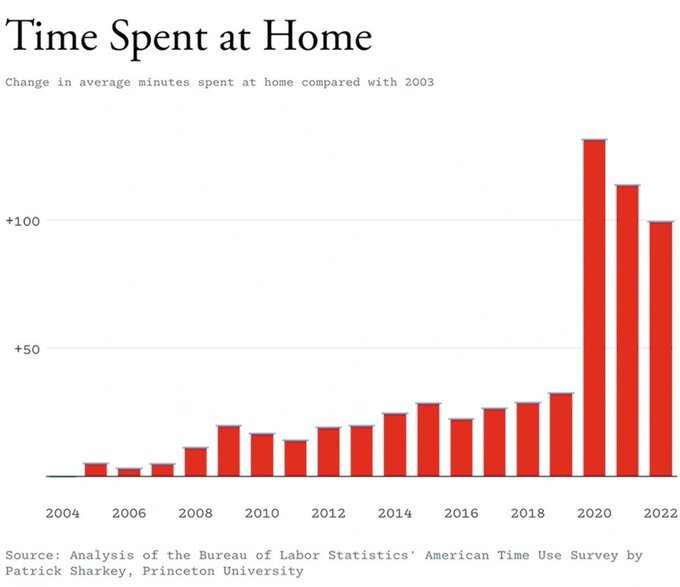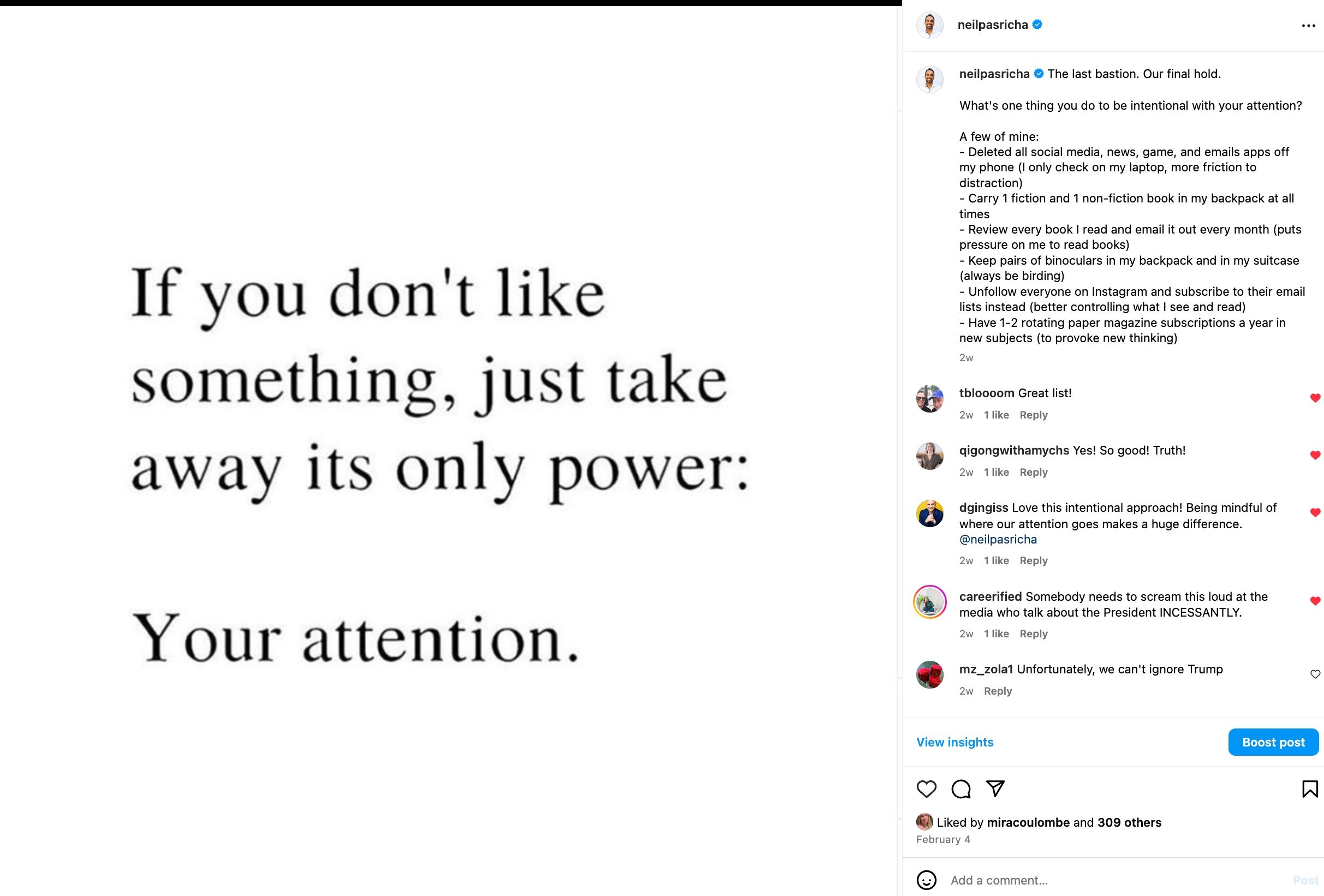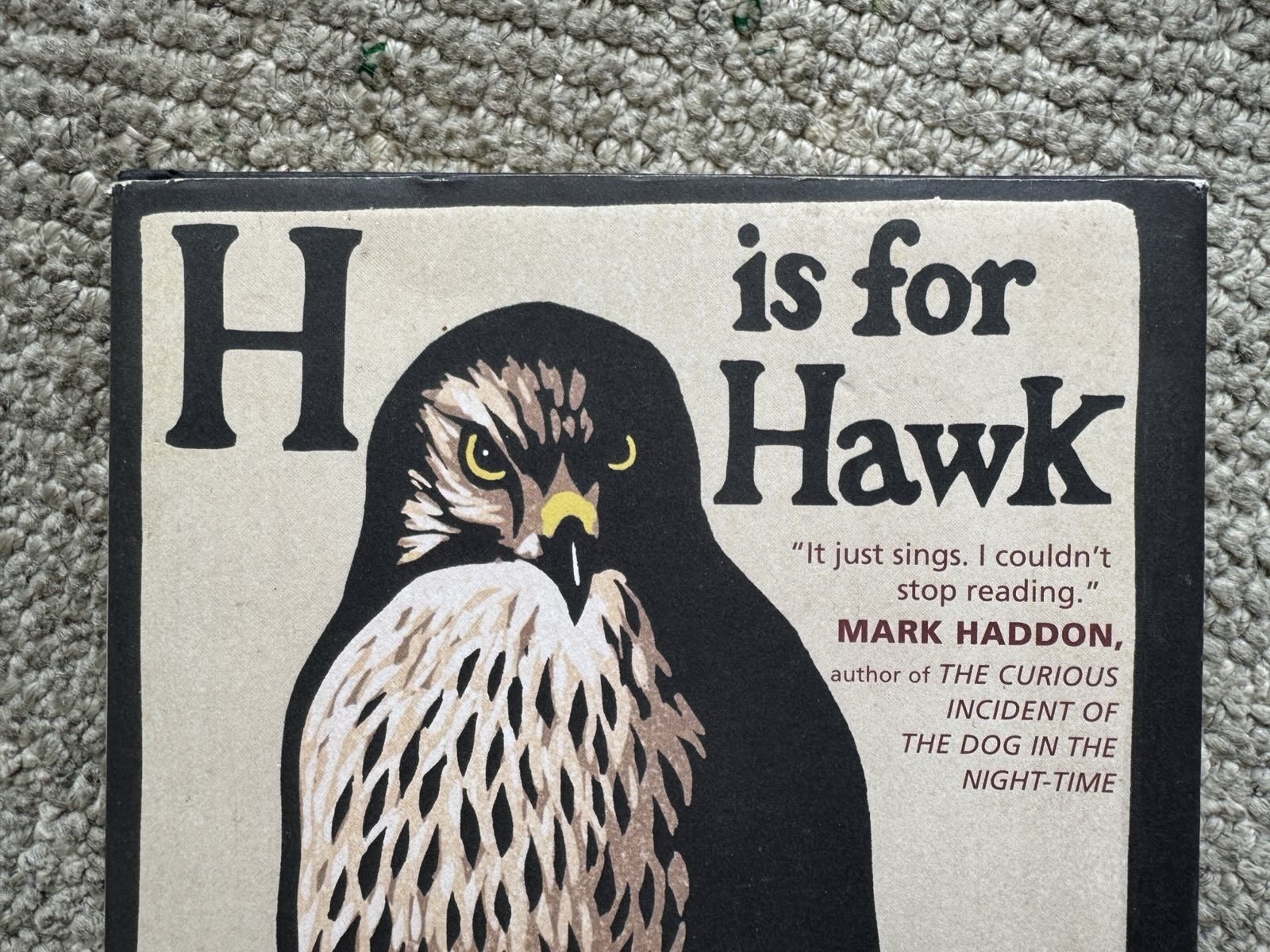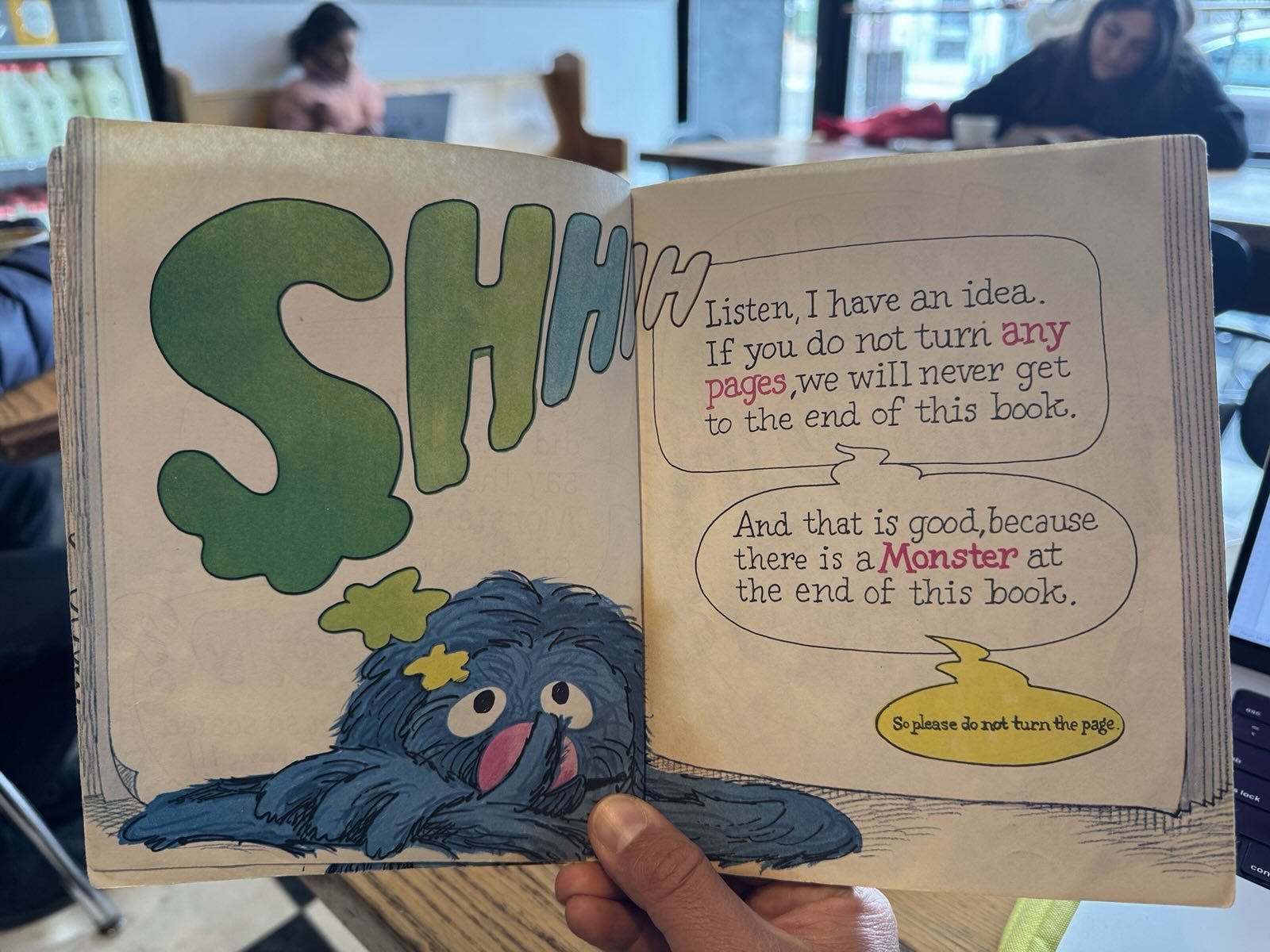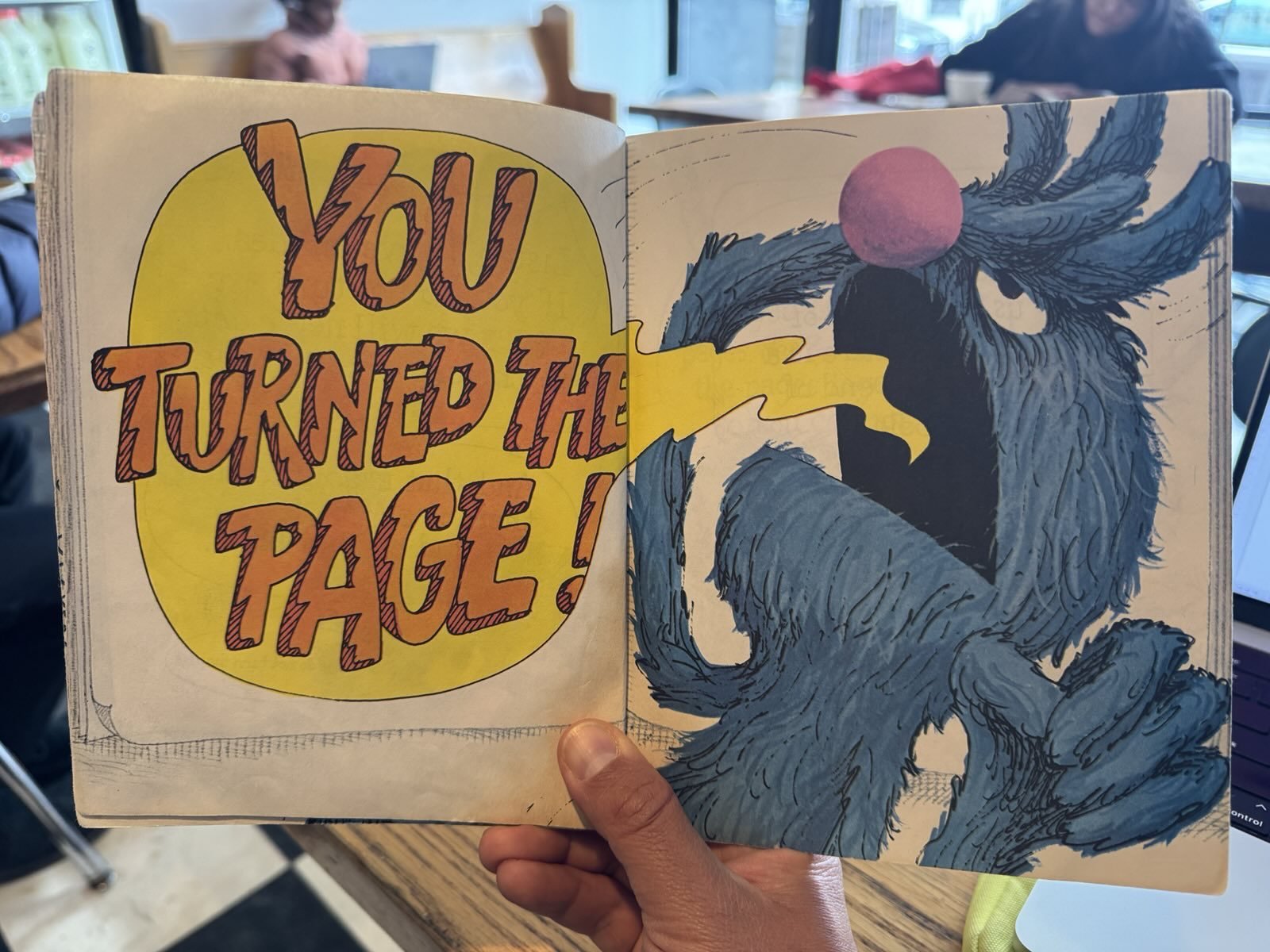0
items
$0
Neil Pasricha's Monthly Book Club - March 2025
Hey everyone,
We’re still reading!
Trying, anyway. Even two pages a night helps! Peeling ourselves off screens an hour before bed lets our pineal gland crank out more melatonin to help us sleep. Less screens, more books!
I love the replies you sent me on last month's book club like from Melissa C who wrote:
Your Bookclub refreshes me. I find new books, I share your thoughts on old favourites; and many of your reviews push me to read a book I have known about but for no known reason avoided (I’m ready for H is for Hawk now!). The Little House on the Prairie series got me through the pandemic. I listened to Cherry Jones read the series via my library app, and it took me away from my worries and anxieties…
I’ll check out Cherry Jones! And I’m hearing a lot of you using library apps like Libby. I do prefer paper, I admit—but all reading is reading! Keep the recos coming. Like this from Casey F:
Apologies if these were in an episode of 3 Books (I am so far behind!), but have you ever read any of the Mrs. Piggle Wiggle books? They're old fashioned, feature lots of different bratty-but-normal kids, and Mrs. Piggle Wiggle is amazing and also a little nuts. PS Read one of the original 4, by Betty MacDonald, not “Happy Birthday, Mrs. Piggle Wiggle” which was completed by her daughter and isn't quite the same.
I haven’t! But now I will add it to my skyscraper-high TBR. I also love hearing your reading stories like from Lidia M:
Dear Neil, I developed a love of reading early in life, I could see the scenes in my head and dreamed the stories at night. The characters peopled my life with vivid images of exotic lives outside of my own and fueled my imagination. I read voraciously. Now, later in life I have little time for devouring books but your reviews inspire me to read and pull me back to when this was so possible. Something I anticipate returning to. Thank you for contributing to keeping this alive for me...
And you for me! Reading isn’t always easy so we need each other’s encouragement. Keep it coming! Just reply to this email anytime…
Now let’s hit the books!
Neil
P.S. Invite others to join us here.
1. Autocracy, Inc.: The Dictators Who Want To Run The World by Anne Applebaum (b. 1964). What is going on in the world right now? There’s an incessant rubber-mallet-to-the-forehead quality in the news. The zone is officially flooded and the overwhelming quantity of cheap misinformation together with the proliferation of bots, trolls, and AI-backed spammers manipulating the algorithms (who are incentivized to feed us anything to draws us in!) threatens to destabilize reality and obscure what’s really happening. This tiny and powerful book by Pulitzer Prize-winning journalist Anne Applebaum zooms up and above the daily “whats” and gives us the more illuminating and horrifying “whys” and “hows.” From page 27: “Everyone assumed that in a more open, interconnected world, democracy and liberal ideas would spread to the autocratic states. Nobody imagined that autocracy and illiberalism would spread to the democratic world instead.” And yet they have! Deeply so. In the first of 5 compressed and highly detailed chapters she writes: “The globalization of finance, the plethora of hiding places, and the benign tolerance the democracies have shown for foreign graft now give autocrats opportunities that few could have imagined a couple of decades ago.” I mean: I remember going on Twitter a decade ago when some big event was happening—the Oscars, the World Series, a big political announcement—and I’d hit the ‘For You’ feed and it was this beautiful cacophony of voices. Now it’s bogged down by unreliable spam. And it’s not just Twitter but most places. I learned in this book that in Central and South America the most common news is Chinese. Chinese news! China is one of a growing number of countries making up “Autocracy Inc” and we learn in Chapter 3 on “Controlling the narrative” how deep the surveillance goes. From page 69 we learn how China requires all Uighur muslims to download
...nanny apps on their phones which constantly search for ‘ideological viruses,’ including Koranic verses and religious references as well as suspicious statements in all forms of correspondence. The apps can monitor purchases of digital books and track an individual’s location, sending the information back to police. They can also pick up unusual behavior: anyone who downloads a virtual private network, anyone who stays off-line altogether, and anyone whose home uses too much electricity (which could be evidence of a secret houseguest) can arouse suspicion. Voice-recognition technology and even DNA swabs are used to monitor where Uighurs walk, drive, and shop.
But it is just oppressed minorities under dictatorships? Or … all of us? It’s not like the autocracies—defined as governments where one person possess unlimited power—are doing the twentieth century thing of pretending they’re giving us utopias. No, on page 74, Applebaum writes that the “…propagandists of Autocracy, Inc., have learned from the mistakes … they don’t offer their fellow citizens a vision of utopia, and they don’t inspire them to build a better world. Instead, they teach people to be cynical and passive, because there is no better world to build.” The decline in power of international organizations—like NATO, the WHO, and International Courts—reduces accountability for autocratic nations to suffer any kind of retribution for breaking global laws. Before our incoming Prime Minister Mark Carney took office a couple weeks ago we saw him resign from private boards and put his personal assets in blind trust to avoid conflict of interests. Contrast this to Presidents selling private crypto-coins or shilling cars from White House lawn. “Come on down!” Language is of course emerging as a battleground. I read with horror about the Newspeak emerging as words such as ‘inclusivity,’ ‘mental health,’ and ‘activism’ are being phased out. Don’t say those words! Can’t say those words! From page 102:
To protect its sovereignty, China seeks to change other kinds of language too. Instead of ‘political rights’ or ‘human rights’, the Chinese want the UN and other international organizations to talk about win-win cooperation—by which they mean that everyone will benefit if each country maintains its own political system. They also want to popularize mutual respect—by which they mean that no one should criticize anyone else.
These words are getting inserted into UN documents and “if mutual respect, win-win cooperation, and sovereignty prevail, then there is no role for human rights advocates, international commissions of inquiry, or any public criticism of Chinese policy in Tibet, Hong Kong, or Xinjiang at all.” Chapter 4 on “Smearing the democrats” shows how reputations in the era of social media overwhelm are taken down by anyone trying to fight for freedom and democracy. Why? Because as Anne writes on page 142 “when something ‘secret’ is revealed about an activist or political figure, perhaps through the publication of a taped conversation or a hacked email, it creates an impression that the person is dishonest and has something to hide, even when the tape or the hacked email contains no evidence of wrongdoing.” This book was published just before the US election of 2024 and there is an ominous close where Anne reminds us on page 148 that Trump seeks to “stoke anger and even violence against people he dislikes, including federal judges” and that “If he ever succeeds in directing federal courts and law enforcement at his enemies, in combination with a mass trolling campaign, then the blending of the autocratic and democratic worlds will be complete.” Is there hope? I mean—yes, thankfully. The closing chapter is a call to arms for people to rise up and fight through legal means the growing autocracy. It’s not easy. But it starts with books. Peeling ourselves off ad-based algorithms full of misinformation wired to confuse us—and getting back into books like this accessible and fearless writeup by a super-articulate history-based Pulitzer-prize winning Yale, LSE, and Oxford-educated journalist. She’s got the chops and she’s breathtakingly fearless in calling spades spades. This is a wake-up call we owe it to ourselves to read, share, and pass along. Highly recommended.
2. Crooked Plow: A Novel by Itamar Vieira Junior (b. 1979). The Atlantic slave trade lasted nearly 400 years from the early 1500s to the late 1800s with over 12 million Africans shipped to toil in plantations across the Americas. The number is actually far higher than 12 million because so many people died en route or upon arriving. (As an aside, the most vivid description of slave ships I’ve read is in the phenomenal novel ‘The Book of Negroes’ by Lawrence Hill.) I didn’t know Brazil is where the *first* slave ships went, the *most* slaves went (nearly half the 12 million), and the *last* slave ships went—with slavery abolished there in 1888. But what is abolished? As Vieira Junior writes through a character on page 170: “My father, she went on, was born almost thirty years after enslaved Blacks had been declared free, when in reality they were still captives of the descendants of their grandparents’ masters.” This is a transporting 276-page novel almost entirely taking place in a camp on a plantation in Northeastern Brazil from early to late twentieth century. It is told in three sweeping chunks by three different narrators. In the first pages a seven-year-old girl named Bibiana and her sister find a knife under their grandmothers’ bed and tragedy ensues with one girl accidentally slicing off her tongue. The writing ingeniously hides what really happened to whom until the second part of the book begins with the story told and expanded upon from the other sister’s perspective. A haunting, fly somewhere far-far-away novel that takes you deep into mud huts on the Água Negra plantation. You feel like you’re there: in the backbreaking labor while “pressing palm oil” and “peeling buriti” and navigating puberty and tragedy and oppression and violence and love. The title of the book is revealed on page 179 through the voice of the tongue-less character: “… the sound that came from my mouth was an aberration, chaotic, as if the severed chunk of my tongue had been replaced by a hard-boiled egg. My voice was a crooked plow, deformed, penetrating the soil only to leave it infertile, ravaged, destroyed.” If you liked ‘Their Eyes Were Watching God’ by Zora Neale Hurston (2/2018) you’ll love this, too. With some pepper shakes of magic realism and an endlessly floaty vibe that leaves you feeling like you’re on a boat. I was sent the book from my friend Wagner Moura (Civil War, Elite Squad) who called it a “beautiful book with strong social criticism and depiction of injustices in poor rural areas.” Published in 2018 and translated into English in 2023 this book won *all three* of Brazil’s top literary prizes.
3. The 5 Types of Wealth: A Transformative Guide To Design Your Dream Life by Sahil Bloom. I struggled to write this review. This book is good. Really good! Did we expect anything less from Sahil (“SA-hill”) Bloom, *the* Sahil Bloom, the potentially most optimized person I’ve ever met, with his six-pack of steel, his membership to the Core Club in Manhattan (where he’s the youngest member), his double-Stanford pedigree (which he jokes in the book and other spots doesn’t keep up with his Yale sister, Harvard dad, and Princeton mom, who still encourages him, to this day, to “try for medical school” (page 5)). Even his haircut is “intimidating”—according to Susan Cain, who makes a wonderful wisdom-drenched cameo on page 229 in a two-pager co-written with Sahil titled, somewhat unSusanny, “Mental Hacks I Wish I Knew At Twenty-Two.” I mean, the man wakes up at 4am every day to take a televised ice bath. He is OPTIMIZED. I picture him discussing one-legged Romanian Deadlift angles and best brands of organic avocado oil in a group chat with Andrew Huberman, Tim Ferriss, and Bryan Johnson. And big respect to all those guys—it’s not easy being so public, pushing yourself, pushing our understanding of how hard pushing is possible. Just for me I … didn’t quite connect with the book the way I expected to and way I often do with Sahil’s wonderful email newsletter The Curiosity Chronicle. On page 7 Sahil writes: “I was thirty years old and making millions of dollars.” And right away it’s like—um, that’s a tough place to connect. He confesses right afterwards that “…the feelings of happiness and fulfillment I expected were nowhere to be found.” We know this! We hear this everywhere. Money doesn’t make you happy! Just that most of us would like the millions of dollars first—you know, just to be sure. Unfulfilled workaholic twentysomething multimillionaire? This is your bible! He speaks, like we all do I suppose, to the me-of-yesteryear. I guess for me that super left-brainy, quantitative, systems-everything guy is still in there, for sure … just a bit distant. I think I kept wanting to *feel* the book more—in my gut, in my heart. But it just kind of put its feet up in my left brain. I like my left brain! I have sticker charts and trackers up the wazoo. But I also think I read, partly, to get away from that, to tone down that side of myself, to enter places of greater vastness and spirit and soul. As ever: right book, right time. And I do think this book will catch people—like it caught famed billionaire investor Bill Ackman, who Sahil shares he reached out to over Twitter for lunch years ago, or billionaire Apple CEO Tim Cook, who Sahil shares he met while working out regularly in a gym in SF at 4am (“There are no losers in the gym at 4:45 AM,” he says). It’ll catch people who maybe need to chill more? Need to call their mom more, need to get outside more, need to sleep more … need to think about money *less*. In some sense this book feels like you fed every uber-popular self-help book (like those that’ve sold >5 million copies) and every uber-popular self-help viral tweet or LinkedIn post (those that’ve been viewed >5 million times) and you stirred, stirred, stirred them together in a big yellow bowl before pouring that chunky batter into muffin-cup chapters and baked it all into something moist and delightfully chunk-free. Don’t get me wrong: I think it’s incredibly hard to do this! I’m just saying that if you’ve read the genre widely then you probably read about the Eisenhower Matrix (pages 96-97) in ‘The 7 Habits of Highly Effective People’; the history of Parkinson’s Law (pages 100-101) in ‘The Happiness Equation’ and, let’s be honest, before that in ‘The 4-Hour Workweek’ (and, before that, probably in ‘Getting Things Done’ by David Allen); and you probably saw Benjamin Franklin’s ‘daily calendar’ (pages 115-116) in … ‘The Autobiography of Benjamin Franklin.’ If you’ve been online a lot you’ve probably seen the viral Ikigai graphic (pages 212-213), heard the Steve Jobs commencement speech (pages 216-217), and heard many versions of famous Joseph Heller “I’ve got something he can never have … enough” story (pages 313-314) a few places. But, of course, those pieces have gone viral for a reason, and finding them all, bringing them together, is no small feat. This is a book full of “life productivity techniques.” Not getting more done, but maximizing yourself on all the scales. On page 55 he encourages everyone to sit down and write a letter to their future selves. This is the kind of thing I want to do, and maybe should do—but it’s hard. It helps that Sahil generously shares the letter he wrote to himself in 2014 at age 23 which includes lines like “You have a lot you hide from the world. You’re insecure. You compare yourself to everyone but yourself.” and “I hope you live closer to your family” and “I hope you’re working on something that feels meaningful.” Now he his! And you love him for it, for finding and following his dream. He details in the opening chapter a story that feels like Tim Urban’s “The Tail End”—about how a friend told him given he only sees his east coast parents once a year, and they’re in their mid-sixties, he’ll only see them 15 more times in his life. Of course, some of the examples on how to correct this, are … kind of funny. Like on page 37, when Sahil discusses Netflix co-founder Marc Randolph's sturdy rule for himself. What’s the sturdy rule? Every Tuesday night Marc makes sure work is “wrapped up by five” so he can have dinner with his wife. He developed the system after working “eighty hour weeks.” I mean, on one hand, sure. But on the other hand, who the heck is working 7am to 7pm for 7 days a week—so much so they need to calendar in a weekly dinner with their wife? I’d resonate more with the story if it was the other way: tracking nights away from dinner with your family, which feels like the more obvious expected baseline. But I do agree: if you never have dinner with your wife scheduling one a week is a good start! Sahil is an eager and hard-working disciple and distiller and his efforts come through. In this 369-page book, stuffed to the absolute brim with tools, models, “razors,” quotes, and heuristics, you will likely find one thing, perhaps many things, that you can reliably and valuably apply to improve your life. This man has the steepest learning curve, the steepest output curve, and one of the sharpest minds of anyone I know. He's in his early thirties and I know will be someone to follow for decades. I can't wait to see what he gives us in 5 years, 10 years, and beyond.
4. What An Owl Knows: The New Science Of the World’s Most Enigmatic Birds by Jennifer Ackerman (b. 1959). A couple months ago my friend Scott and I were traipsing through knee-deep snow in -20C/-4F weather just after sunrise way, way out on the Leslie Spit—an ancient garbage pile poking into Lake Ontario that’s since evolved into a bird paradise—when we suddenly saw a Long-Eared Owl glowering at us. Scott snapped a picture, we stepped backwards, one of us stepped on a stick that cracked and just like that the bird was gone. But what a picture he nabbed!
I don’t see owls very often. None of us do! That word “enigmatic” is so perfect—“hard to understand or explain, inscrutable or mysterious” according to Merriam Webster—when describing these 60-million-year-old (!) birds. For reference, Home Sapiens have been around 300,000 years and Homo Erectus were about 1.5 million years ago. Said another way: This planet belongs to the owls. We just live here! What an intoxicating and never-ending pleasure of trivia this book is as we follow the warm and sagacious Jennifer Ackerman through her pilgrimage to better understand these fascinating birds. From page xvii: “Why do an owl’s eyes, alone in the bird world, face the same way ours do? What made the early ancestors of owls cross the boundary into night?... How are owls adapting to shifts in their habitat and global climate?” First up! Where did they come from. Well, “like all birds, they initially arose from a group of small, mostly predatory, running dinosaurs that were coexisting with other, larger dinosaurs sixty-six million years ago.” The trivia is endless: “Of the 11,000 or so species of birds alive today, only 3 percent have adaptations that allow for stalking prey in the dark.” Feathered talons help! As do satellite dome faces! And the ability to hear a mouse running under a foot of snow! We learn on page 90 that “if a nesting Great Horned Owl is threatened by a dog or other predator, it will fluff up its feathers and throw itself to the ground, flapping around as if its wing is injured and squealing once or twice…” and on page 91 that “owlets begin vocalizing in the egg, even before they hatch.” Btw, did you know Great Horned Owls consume over *500* species? From shrews to rats to jackrabbits to ducks to ferrets to foxes to skunks! (They don’t smell skunks like pretty much everything else making them the only predator for most skunks, which are 3 times as heavy!) WATCH OUT EVERYTHING! I love this book. It’s owl trivia forever. From “Female Snowy Owls choose to breed only with males that are really white” (page 126) to the fact that Burrowing Owls decorate their nests which chunks of concrete decorations or “122 pieces of coyote scat” (page 132) to problematic issues like Japan’s “owl cafés” (page 213) or The Hedwig Problem, where Harry Potter created a bit of a global boom on illegal owls as pets. Quiet, mysterious, ever-hidden, ever-lurking, this is a wonderfully curious and scientific look into the 254 species of owls we share the planet with.
5. Birds by Kevin Henkes, illustrated by Laura Dronzek. Another book about birds but this one takes about 1/10,000th the time to read. A little girl looks out her window and describes birds from the simplest possible lens—but with enough little a-has that give the book angles and wonder. Like a quick scene when she says she sees birds sitting still on a wire for a long time and then looks back and they’re all gone or when she sees birds all take off and it looks like the tree is sneezing. Great one for your tiniest! Have it read-a-loud to you on YT right here.
6. Useful Not True by Derek Sivers. I remember way back in 2010 when I was working in Leadership Development at Walmart and this little 5 minute TED Talk went viral internally called “How To Start A Movement.” I loved it! All about the leadership of “first follower” as told through a hill of people dancing at a music festival. It was vintage Derek Sivers, though I didn’t know who Derek was at the time—with his unique blend of poetic wisdom distilled, distilled, distilled down into simple parts. The man is obsessed with simplifying! He let me use his wonderfully distilled “horse fable” in the Introduction to ‘You Are Awesome,’ my book on resilience, and I remember when his personal website was at sivers.org but he must have thought that URL was too flabby because he got it from 10 characters to 7 with sive.rs. (Btw, bookmark his “Book Notes” over there—a wonderful summary of what he’s read.) Now comes his newest book! Another slim self-published hardcover that in 88 pages takes us from “Almost Nothing People Say Is True” to “Your Thoughts Aren’t True” to “Ideas Can Be Useful, Not True” to “Adopt What Works For You.” He makes the simple point over and over: we make stuff up. That’s how we live. We adopt beliefs, we tell ourselves stories, we create realities that aren’t true—but they help us navigate through life. So, given that, we may as well make up things that help us. The idea reminds me of a familiar refrain in Cheryl Strayed’s ‘Tiny Beautiful Things’ (10/2020)—that we should let go what isn’t serving us and adopt beliefs or behaviors that do. Ironically, even though Derek’s the king of simple and short writing, I did feel like I could glean the entire takeaway of this book through the chapter headlines. But for me this is a reminder book: something to set on your shelf, and face outwards, when you find yourself stuck chasing a dream or a wish or an ideal that … maybe doesn’t help you? A ”from first principles” book that’s useful to reduce guilt, inspire direction, or get unstuck.
7. Slowness: A Novel by Milan Kundera (1929-2023). I read this whole novel and am not exactly sure what just happened. I heard it described as the “most accessible” of the famed exiled Czech novelist’s works and, uh, well, now I’m scared of the rest. This is the first novel Kundera wrote in French and it’s a completely disjointed narration of a midsummer’s night with a series of abstract tales of seduction—centuries apart!—all woven together. Modern art! Hard to follow! But punctuated with moments of such clairvoyant poignancy that I alternated between frustration and delight. From page 3:
Why has the pleasure of slowness disappeared? Ah, where have they gone, the amblers of yesteryear? Where have they gone, those loafing heroes of folk song, those vagabonds who roam from one mill to another and bed down under the stars? Have they vanished along with footpaths, with grasslands and clearings, with nature?
I like that. This is my kind of guy! A wanderer of hills, a lover of nature. And then he keeps going:
There is a secret bond between slowness and memory, between speed and forgetting. Consider this utterly commonplace situation: a man is walking down the street. At a certain moment, he tries to recall something, but the recollection escapes him. Automatically, he slows down. Meanwhile, a person who wants to forget a disagreeable incident he has just lived through speeds up his pace, as if he were trying to distance himself from a thing still too close to him at times
I learned that this particular paragraph was part of Carl Honoré’s inspiration to write the wonderful ‘In Praise of Slowness’ (5/2020), which I’m revisiting these days. A confusing, poignant, flowing funny, and genuinely weird book.
8. ‘The Anti-Social Century’ by Derek Thompson in The Atlantic. Do you think that spending time on social media is… social? I know it is *social* media, but is it social the way The Olive Garden is Italian? If you think it's social, you will disagree with the thesis of this article which begins at a restaurant that permanently closes its bar after Covid and evolves into Robert Putnam-like analysis of key figures, variables, and metrics that seem to be accelerating both our loneliness pandemic and our left brain’s desire to always be alone. But our hearts and our bodies desire to be together … To hang out with friends. One key chart:
We went inside for the pandemic... and we didn't come out! Is that a problem? Yup! As Thompson writes (and the bold is mine):
...people who spend more time alone, year after year, become meaningfully less happy. In his 2023 paper on the rise of 21st-century solitude, Atalay, at the Philadelphia Fed, calculated that by one measure, sociability means considerably more for happiness than money does: A five-percentage-point increase in alone time was associated with about the same decline in life satisfaction as was a 10 percent lower household income. Nonetheless, many people keep choosing to spend free time alone, in their home, away from other people.



